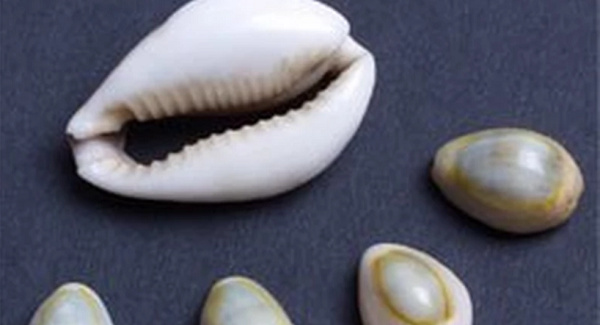The origin story of cowrie shells, their significance and symbolism

You may have a vague understanding that cowries were once used as currency in ancient times. You might even associate cowrie shells with the Western culture in Nigeria, particularly among the Yorubas.
But let’s pause for a moment and reconsider; are our assumptions about cowries accurate? How has the common cowrie we’ve always known been a symbol of wealth and cultural significance?
Join us on this journey as we unravel the mysteries surrounding the origins of cowrie shells:
What are cowrie shells?
Cowrie shells are small, smooth shells that have a shiny, porcelain-like appearance and are usually light beige in colour.
They possess an elegant oval shape and are characterized by a ventral aperture, which creates a distinct division down the centre of the shell.
Cowries belong to the sea snail family, which is why they are often referred to as shell money.
While cowrie shells are primarily found in the Indian Ocean, they gained immense popularity throughout ancient Africa. Interestingly, the term “cowry” may sound like an English word, but its origins lie in Hindi. In Hindi, “cowry” translates to sea snails, providing insight into the name’s true meaning.
Where do cowries originate from?
It might come as a surprise that cowrie shells, also spelt cowry, were not created by Africans or the English. These shells originate from the sea.
According to Wikipedia, cowrie shells are most abundant in the Indian Ocean and were collected from various locations such as the Maldive Islands, Sri Lanka, the Indian Malabar coast, Borneo, East Indian islands, Maluku in the Pacific, and different parts of the African coast from Ras Hafun to Mozambique.
The primary source of cowrie shells was the Maldives in the Indian Ocean. They were initially obtained from there and brought to West Africa through the trans-Saharan trade and European merchants.
In Nigeria, cowrie shells are known by different names in different languages. The large cowries are called Nwefe or Okpokpo by the Igbos, while the smaller ones are referred to as Ayola. Among the Yorubas, they are known as owoeye, while the Fulanis call them Sedere. In Bini language, they are called Bosjes or Igvo.
What is the significance of cowries?
Did you know that the very cowrie shells we casually wear today once held immense significance as symbols of wealth and currency for centuries? These shells served as a universal form of exchange, deeply ingrained in the cultural fabric of ancient African societies.
The durability and lightweight nature of cowrie shells made them an ideal medium of trade long before the advent of paper or coin currency like pounds or dollars. Native Africans recognized cowries as a vital means of payment and a representation of wealth and power, a belief that endured until the 20th century.
Remarkably, cowrie shells are considered to be the earliest pan-regional currency in West Africa.
What did the cowrie shell symbolise?
In the olden days, cowrie shells held profound symbolism as representations of fertility and prosperity. These shells possessed a culturally specific value that touched various aspects of life.
Cowrie shells were believed to play an active role in divination due to their white colour and their association with the ancestral realm. Divination, in turn, encompassed concepts of ancestry, fertility, and healing. It comes as no surprise then that cowrie shells were often adorned by priests who communicated with the gods, as depicted in Nigerian movies portraying the ways of the ancient people.
In some other contexts, the voluptuous shape of the cowrie shell was linked to the feminine form, with the curved back symbolizing a pregnant woman. Some historians even suggest that the jagged side of a cowrie shell represented an eye or the vulva of a woman.
Also, according to African legends, cowrie shells represented the powerful protection of a goddess, which is highly connected to the strength and might of the ocean.
With their resemblance to the life-giving organs of females, these shells were also referred to as elixirs or givers of life.
The symbolic significance of cowrie shells spans a rich tapestry of cultural beliefs and interpretations. From their ties to divination and ancestral connections to their association with femininity and divine protection, these beautiful and small shells have deep spiritual meanings that have transcended time.
Cowries in modern culture
In recent years, cowrie shells have found a special place in pop culture, becoming a trendy accessory embraced by many.
People now incorporate these shells into various elements of their style, from attires to hairstyles.
It is increasingly common to see Nigerians proudly adorning cowrie shells, intricately woven into their braided and dreadlocked hairstyles.
These shells are also used in the creation of traditional African-inspired headpieces, adding a touch of cultural heritage to contemporary fashion.
Notably, cowrie shells have gained the attention of celebrities as well. Icons like Beyoncé and Seun Kuti have effortlessly rocked the cowrie look, further popularizing their appeal and inspiring others to embrace this timeless adornment.
The enduring presence of cowrie shells in modern culture is a proof of their timeless beauty and relevance.
Source: pulse.ng





